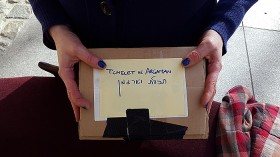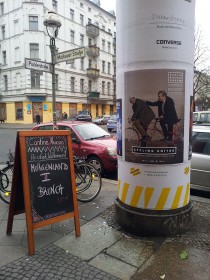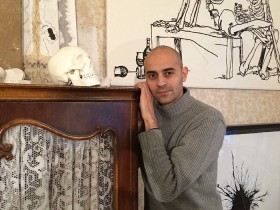
When delivering her art works to the Jewish Museum Berlin, Deborah S. Phillips naturally wears blue nail polish © Jewish Museum Berlin. Photo: Gelia Eisert
A visit to Berlin-Neukölln, to the studio apartment of Deborah S. Phillips, who is dressed in blue, today, except for her shoes, which are green. That the artist has spent the last five years examining the color blue and is only now gradually turning her attention to hues of green is reflected thus in her apparel as well as her art.
Red was the first color to which Deborah Phillips devoted herself with a passion. The Bible story she read aloud as a 12-year-old in the synagogue on the occasion of her Bat Mizwa was about the red cow—and it haunted her for ages. It was the tale of a strange animal that had to be sacrificed so people could use its ashes to cleanse themselves of sin. Only then would they be able to enter the temple in Jerusalem. Many years later, Deborah Phillip’s reflections on the color red and its cultural significance culminated in one of her enchanting works on paper, the “Red Book,” which is the fruit also of the artist’s extensive voyages in Iran, India and Central Asia, and her affinity with Islamic cultures. → continue reading
Pessach is approaching – the festival of exodus and freedom. This year, there is less talk of having the festive meal at large community gatherings. It is obvious, although unspoken, that smaller gatherings in the home make more sense. We are becoming alienated from our community centers through fear. Keep a low profile. Don’t speak Hebrew on the streets. Some people are removing the mezuzah from their front doorposts, a traditional object that visibly identifies a Jewish household. There is a mood of caution and nervous apprehension.
How did it get to this point?

Advertisement with Imam Ferid Heider and Rabbi Daniel Alter for the “Cycling Unites”-Critical-Mass-Tour in Berlin on 22 March 2015, photo: Michal Friedlander
June, 2014
A drunken man rolls slowly off the train platform and plops onto the tracks at Friedrichstrasse station. Around sixty people witness the moment and look away, hoping that someone else will solve the stinky, awkward problem. And so it was. An Italian and an Israeli jumped down to haul the semi-conscious man to safety. The passengers walked around the startled little group, pressing forward to make the oncoming train.
July 2014
Dinner party small talk. The discussions nearest me are taking a more political turn and I am just not in the mood to talk about Israel. Too late. The young man next to me asks if I saw the recent pro-Palestinian demonstration on the Kurfürstendamm? He becomes very still and lowers his voice. → continue reading

Victor Alaluf in his studio in Berlin-Friedrichshain © Jewish Museum Berlin, photo: Denis Grünemeier
A retro-style armoire with a skull sitting on top of it—a piece from the collection of Victor Alaluf, an artist with Argentinian roots whom I interviewed recently in his studio in Berlin-Friedrichshain.
In his work—installations, mainly, comprised of drawings, collage, sculpture, video art and everyday objects—Alaluf addresses the existential issues raised by our experience of death, pain, and the ephemeral and fragile nature of all living creatures. His choice both of material and objects is decisive. He frequently chooses brittle materials, such as glass or ceramics, as well as organic matter, such as human hair and blood. Alaluf has a particular penchant for → continue reading


